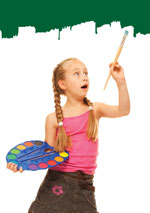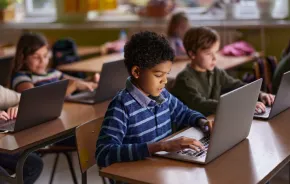 Getting a taste of the arts in elementary school — learning an instrument, performing in a play — should, it seems, be a given. In Washington state, however, education in music, drama and art at the public elementary school level has become endangered.
Getting a taste of the arts in elementary school — learning an instrument, performing in a play — should, it seems, be a given. In Washington state, however, education in music, drama and art at the public elementary school level has become endangered.
A 2005 Arts Education Resources Initiative study conducted by the Washington State Arts Commission shows that although state law mandates arts education, many public elementary schools lack a paid visual arts instructor. “Creating time for arts courses is a challenge in this climate of high-stakes testing for reading and math,” the study reports.
Deva Demeter, a mother of two, has been the art enrichment chairperson for Redmond’s Einstein Elementary School for the past four years. Before that, students weren’t receiving regular art instruction, says Demeter. Einstein, like many of Washington’s public elementary schools, has no paid art instructor or dedicated art room. The art enrichment program is a volunteer-run program sponsored by Einstein’s Parent Teacher Student Association (PTSA). Einstein’s students receive an hourlong lesson once a month through the program.
“I think parents need to be aware of the value that art education provides,” says Demeter. “It teaches kids to look at the world in different ways and encourages creative thinking that leads to new ways to help people and communities. It develops spatial reasoning and it gives kids a chance to express their ideas and their point of view.” Participating in art develops self-esteem, she says, and offers kids the chance to learn a variety of skills.
The value of including art instruction in public elementary schools is recognized on the state level but, as Demeter reports, is not followed with any additional funding to support meeting the goals. Demeter says that that current state mandated Essential Academic Learning Requirements (EARLS) for art education on the elementary level directs “that every student would work with clay, a variety of paints, sculpting supplies and many other media that are not provided with the funding we have — and which have this year suffered additional cuts.”
In contrast to the experience of many public school students, kids attending private elementary schools are often offered art, drama and music instruction. At Three Cedars Waldorf School in Bellevue, kids — from preschool on up — learn movement training, drawing, painting, modeling and singing, and produce class plays, says executive director Briana Bennitt. “For learners who are not strongest in verbal/linguistic or abstract mathematical reasoning — and we estimate that 60 percent of students are not — the opportunity to connect successfully with schooling via other pathways, honoring all of the multiple intelligences, is critical,” Bennitt says.
Pulling together
Recognizing the need to provide more art, drama and music experiences for public elementary school students, some nonprofit and service organizations are partnering with local schools. The Moonpaper Tent Theater in Seattle’s Roosevelt neighborhood offers a school theater program, and Redmond’s Evergreen Family Theater brings theater to local schools through its “Stage Coach on Wheels” program.
Rotary’s Music4Life program supports expanding music instruction in Seattle public schools and has provided instruments to more than 150 students. “Research shows that instrumental-music instruction allows a child’s brain to develop in ways that make them much more able to learn in other disciplines such as math, science, history, foreign languages, even computer science,” says David Endicott, the program’s president.
Often, students from financially challenged families can’t participate in school instrumental-music instruction, he says. “As a result, those who can participate in instrumental-music programs tend to be those who come from well-to-do families or those who can demonstrate unusual musical talent and, thus, can generate financial support.”
While parents appreciate the work that partnerships and service organizations are doing to bolster arts education, many recognize it isn’t an ideal system. Demeter says that as much as she loves being an art enrichment volunteer, “I would gladly give it all up if I showed up at school this fall and there was a full-time art teacher teaching in a well-stocked art room.”
Kathleen F. Miller is an art docent at her children’s school and recently volunteered at the Kids Fair section of the Bellevue Festival of the Arts.











